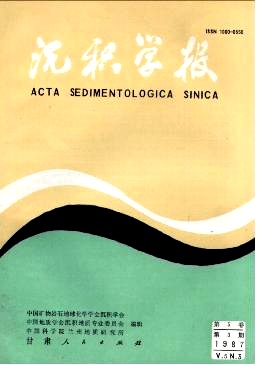SEDIMENTARY STRUCTURE AND ENVIRONMENTAL EVOLUTON OF SUBMERGED DELTA OF CHANGJIANG RIVER SINCE LATE PLEISTOCNE
- Publish Date: 1987-09-10
Abstract: According to the analysis of cores Ch1(99 m), Ch2(63 m) and Ch3 ( 39 m), which were drilled in the outside of Changjiang River estary by the Institute of oceanology, Academia Sineca, the submerged delta of the Changjiang River formed in post glacial period consists of foreset, bottomset and marginal deposit. The fore set usually is over 10-14m in depth, divided into two parts: the upper part is generally composed of yellowish silts which contain many marine mollusk larva shells, and the lower part is the interbeds of thin silt and clay layers, both indicate the variablity of sedimentary environments. The lower boundary of the bottomset is at the depth of 22.07-46.5m, it is about 20-30 m thick and consists of grey clay sediments showing a stable and fine grain depositional period. Most of the cores contain thin silt layers in the bottomset by which the bottomset also can be divided into two parts, the upper softer part and the lower harder part. The marinal deposit is mainly composed of thin unsorted silt-fine sands it contains a lot of well preserved marine mollusk fossils, representing a typical littoral environment. Under the marginal deposit is the silt sediment formed in Wurm glacial term during the low sea level, in which developed thin peat sediments e.g. at the depth of 36.14-36.16 m in core Ch1 , the dark pure peats with 14C age of 10790 ± 120 years B.P., and at 48.4m, with 14C age 18740 ± 650 years B.P.. In the middle Late Pleistocene, a set of graval sediments in Ch1 deposited at 76.03-76.10 m. There are the preserved truncks with 14C age36000 years B. P. We found an individual of Pseudorotalia gaimardii at 62 m and 70m respectively, and some fresh water Lamprotula sp. at 76 m and 84 m. Beneath 84.24m there is a discontinuous surface. The middle Pleistocene sediment of Ch1 consists of clay layer intercalated with fine sand. The thermoluminescent dating at 88.2 m, 88.3m and 91.8m are (215 ± 10.7)×103, (233±11.6)×103 and (255± 12.3)×103 years respectively. There is a discontinuous surface at 91.96 m. From the above-mentioned data, the studied area was a land deposit environment in the late Middle Plesitocene. During the subinterglacial of Wurm glaciation a transgression occurred, later, in the Wiirm glaciation maximum it became a lake environment. Finally, when the climate was getting warmer in Holocene, the area changed to a neritic environment again and with the growth of the river estary delta, the mordern submerged delta system of the Changjiang River has formed.
| Citation: | Qin Yunshan, Zhao Songling. SEDIMENTARY STRUCTURE AND ENVIRONMENTAL EVOLUTON OF SUBMERGED DELTA OF CHANGJIANG RIVER SINCE LATE PLEISTOCNE[J]. Acta Sedimentologica Sinica, 1987, 5(3): 105-112. |






 DownLoad:
DownLoad: